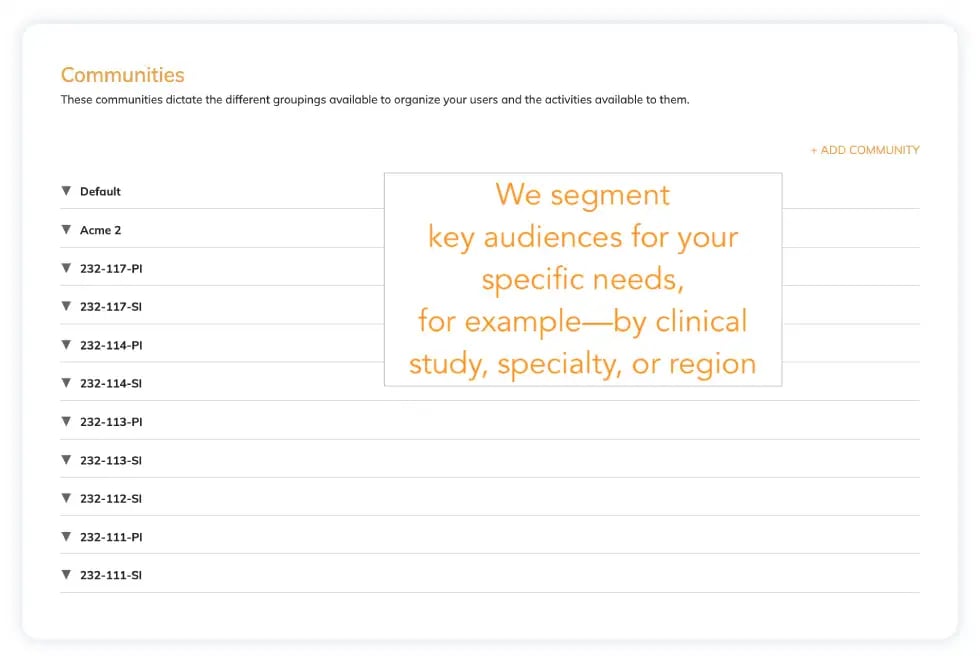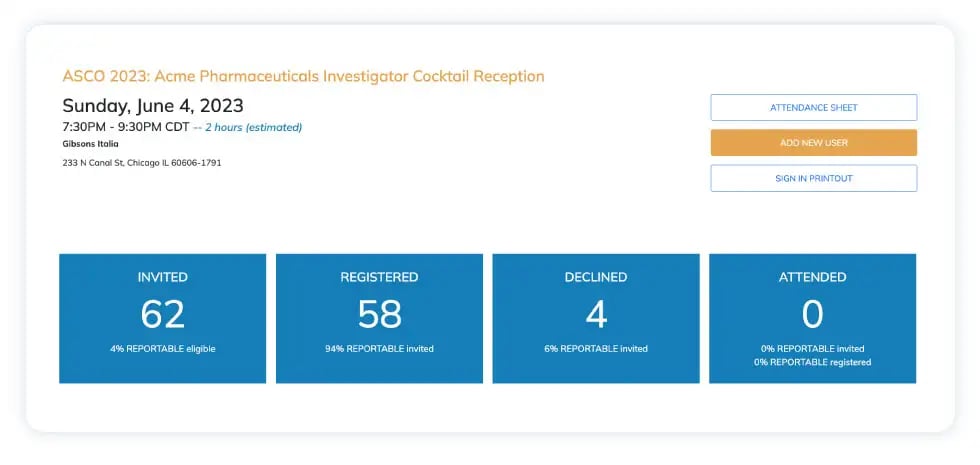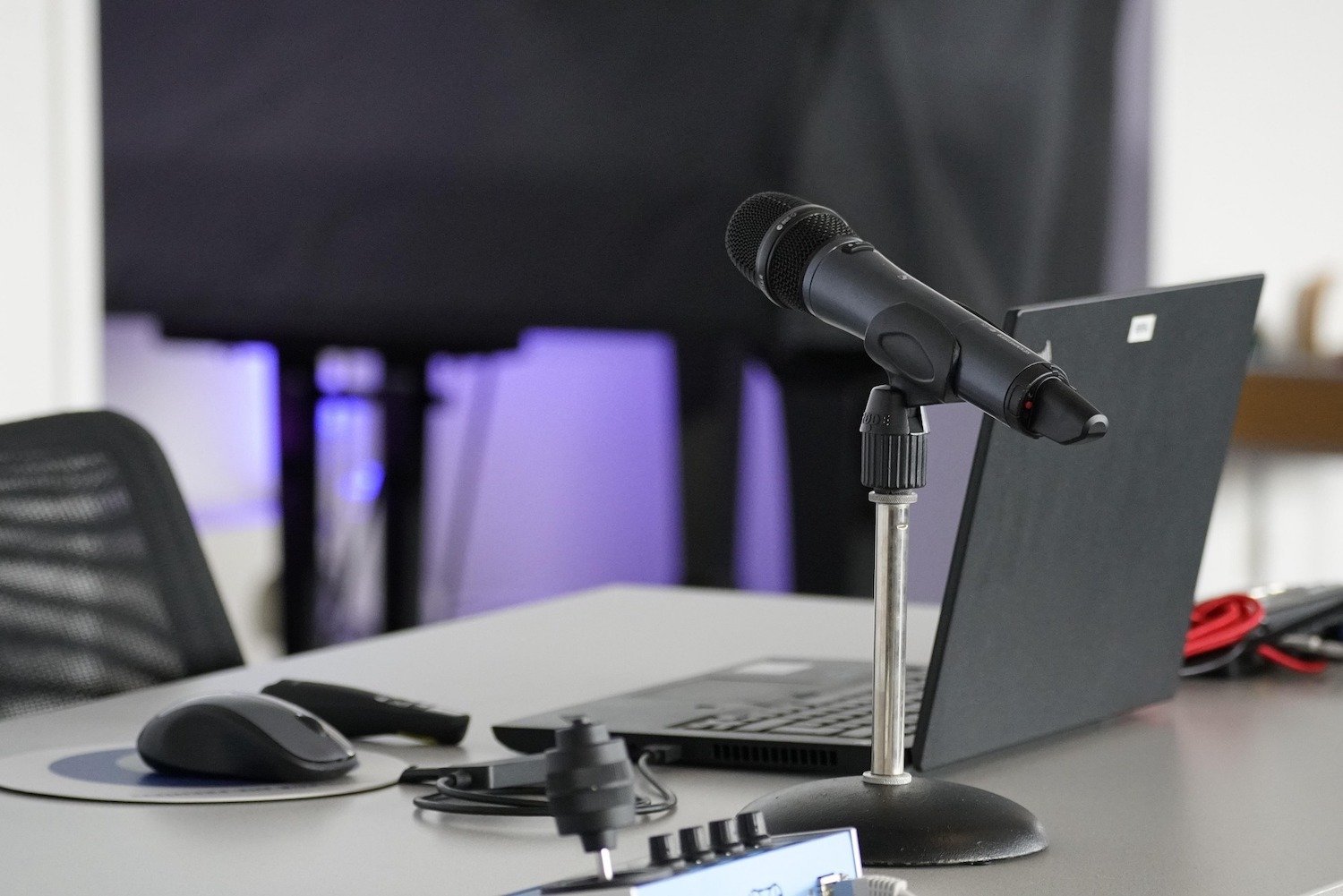In case your time is short:
The AAD Annual Meeting 2026 (March 27-31 in Denver) brings together over 20,000 dermatologists, researchers, and healthcare professionals—making it the world's premier dermatology meeting. Success at this event requires more than just showing up.
Here's how to maximize your impact:
Step 1: Start planning now
With 20,000+ attendees and hundreds of concurrent sessions, your outreach should begin 4-5 months before the event. Segment your dermatology KOLs by subspecialty (medical, surgical, cosmetic, pediatric derm, etc.) and start personalized invitations this fall.
Step 2: Consider how best to navigate the AAD event space
Unlike smaller specialty meetings, AAD features distinct tracks for medical dermatology, aesthetic medicine, surgical procedures, and emerging therapies. Map your team's presence across these domains to maximize connections.
Step 3: Plan for the Innovation Academy
AAD's Innovation Academy showcases cutting-edge technologies and novel therapeutic approaches. These sessions offer unique opportunities to engage with forward-thinking dermatologists interested in the latest advances.
Step 4: Don't miss the late-breaking research sessions
With rapid advances in biologics, JAK inhibitors, and targeted therapies for conditions like atopic dermatitis and psoriasis, the late-breaking sessions are crucial for KOL engagement around emerging data.
Step 5: Leverage the poster sessions strategically
The expansive poster halls require strategic planning. Equip your team with QR codes and digital tools to efficiently capture insights from hundreds of presentations on topics ranging from acne to melanoma.
Teams using ExtendMed's Health Expert Connect™ platform consistently report deeper, more valuable KOL connections at major events like AAD—compared to the fragmented, manual approaches many teams still rely on. Contact us for a free personalized demo.
We've been helping pharmaceutical companies navigate medical congresses for years, and AAD's Annual Meeting presents a ton of opportunities and challenges for teams looking to connect with dermatology thought leaders.
Where other meetings might have narrower focuses, AAD brings together 20,000+ professionals spanning everything from pediatric dermatologists managing eczema in infants to Mohs surgeons performing complex reconstructions to researchers developing novel gene therapies for rare skin diseases.
The diversity of stakeholders means you have to think strategically going into an event like this. You can't just show up with a booth and hope for the best—not when your target KOLs might be scattered across dozens of session tracks happening simultaneously in the massive Colorado Convention Center.
This is exactly why we built Health Expert Connect™—to help teams manage this complexity without drowning in spreadsheets, emails, and compliance concerns. In this guide, we'll share our playbook for AAD and show how an engagement platform can help you maximize the ROI on events like this.
Inside the AAD Annual Meeting
Before really diving into strategy here, it's worth stepping back just for a second to understand what makes AAD unique from other major medical meetings.
The dermatology community is notably collaborative yet specialized. Many derms have trained at the same institutions, collaborate on research, or serve together on committees developing treatment guidelines.
This creates both opportunities and challenges for engagement.
Unlike some specialties, dermatologists often practice across multiple domains. Your target medical dermatologist might also perform cosmetic procedures, conduct clinical trials, and teach residents. This means simple categorization won't work—your outreach strategy needs to reflect the full scope of each KOL's expertise and interests.
This is exactly where platforms like Health Expert Connect™ become invaluable for congresses and events like this. Our system lets teams tag KOLs with multiple attributes—clinical focus, procedural expertise, research interests, institutional affiliations, engagement history—and build dynamic segments for more targeted outreach.
There’s no more juggling separate spreadsheets for "psoriasis experts" vs. "melanoma specialists" when the same physician may be deeply involved in both.
 ExtendMed’s Health Expert Connect™ platform efficiently consolidates and manages multiple lists of healthcare professionals, ensuring a smooth event invitation process.
ExtendMed’s Health Expert Connect™ platform efficiently consolidates and manages multiple lists of healthcare professionals, ensuring a smooth event invitation process.
The meeting itself reflects this complexity. AAD organizes its content across several key domains:
- Medical Dermatology: Inflammatory conditions, infectious diseases, and systemic therapies
- Surgical Dermatology: Mohs surgery, reconstructive techniques, and skin cancer management
- Cosmetic and Aesthetic Dermatology: Injectable treatments, laser therapies, and practice management
- Pediatric Dermatology: Childhood skin conditions, genetic disorders, and developmental considerations
- Basic and Translational Science: From molecular mechanisms to therapeutic development
- Global Health and Diversity: Skin conditions across different populations and care settings
Each of these domains has its own thought leaders, session formats, and networking opportunities.
A smart engagement strategy needs to reflect this segmentation while staying flexible enough to capture valuable cross-domain insights.
Pre-meeting strategy: the 5-month playbook
Over the years, we've supported many congress and medical meeting engagement campaigns and have found that the most successful teams start planning months in advance. While you can compress the timeline if needed, this month-by-month cadence gives your team a comfortable, proactive rhythm.
|
|
|
|
Maximizing on-site engagement at AAD
The Colorado Convention Center in Denver spans multiple levels and buildings. Navigating it effectively takes planning.
Here are some tips to help your team make the most of their time on site.
Cover your sessions strategically
Unlike smaller meetings where you can cover everything, AAD forces you to prioritize.
We recommend focusing on key areas (see below). Teams using Health Expert Connect™ easily assign session coverage and track it in real time—no more last-minute scrambles.
|
|
Capture insights systematically (not ad hoc)
One of the biggest risks at a large congress like AAD is losing valuable insights in the shuffle. Health Expert Connect™ gives teams structured, consistent ways to capture and share what they learn:
| For KOL Meetings |
|
| Session Coverage |
|
Navigate the poster sessions efficiently
AAD's poster sessions—spanning everything from basic science to clinical outcomes—require an organized approach. Your team needs tools to capture insights quickly and thoroughly.
Health Expert Connect™ helps teams tackle this through:
- Pre-meeting preparation: Upload abstract numbers and assign team coverage.
- Rapid capture tools: Quick forms for capturing presenter contact info and key insights.
- Follow-up automation: Systematic process for scheduling deeper conversations post-congress.
- Team coordination: Real-time updates on which posters have been covered.
We strongly recommend mapping out your poster strategy ahead of time. Divide the team so you're covering as many relevant sessions as possible, rather than having everyone cluster around the same handful of presentations. We've seen teams capture 3x more meaningful poster insights using this systematic approach compared to traditional note-taking.
Track compliance accurately (and without the headaches)
Many dermatologists work at institutions with strict policies regarding interactions. Manual compliance tracking doesn't scale at a meeting like AAD, where your team may have dozens of members engaging with hundreds of KOLs across multiple venues.
Health Expert Connect™ automates compliance management:
- Institutional spending tracking across your entire team's interactions.
- Payment processing with built-in compliance workflows.
- Expense reporting that handles Sunshine Act requirements.
- Contract management for all KOL engagements.
At an event as complex as AAD, this kind of automation is critical. Without it, teams quickly get buried trying to manually track compliance across a mountain of interactions.
Dermatology-specific engagement opportunities
Beyond the standard congress playbook, AAD offers unique engagement venues, including:
- Diversity Champion Workshop — AAD's commitment to diversity in dermatology creates opportunities to engage with leaders focused on improving care across all skin types. Participating positions you as committed to inclusive dermatology.
- Innovation Academy — This dedicated space for emerging technologies and startups offers more intimate settings for discussing cutting-edge approaches to skin health. It's particularly valuable for companies with novel mechanisms or digital health solutions.
- Residents and Fellows Forum — Don't overlook the next generation of dermatology leaders! These sessions attract ambitious early-career dermatologists eager to learn about the latest advances. The smaller settings often yield candid insights about training gaps and unmet needs.
- Subspecialty Society Meetings — Many dermatology subspecialty groups hold meetings adjacent to AAD. The Society for Pediatric Dermatology, American Society for Mohs Surgery, and others offer focused engagement opportunities with specialized KOLs.
Post-AAD follow-up
This is where having a platform like Health Expert Connect™ really shines. While others scramble with business cards and scattered notes, our users execute systematic follow-up.
Let's start with organizing your insights immediately after the event—a huge pain point for those without a system.
Within 24 hours of AAD ending, you'll have:
|
Then we move to actually turning those connections from the event into lasting relationships through. Here’s how we do it—in sequence:
| Immediate Actions (48 hours) |
|
| Medium-term Nurturing (2-8 weeks) |
|
| Long-term Relationship Building (ongoing) |
|
Why an integrated platform matters at AAD
We've seen brilliant medical affairs teams—people who can talk for hours about the latest JAK inhibitors or emerging gene therapies—get completely bogged down by the operational chaos of a major congress.
Here's how it usually happens:
They start by sending outreach emails. Then they manage responses in spreadsheets. Expenses are tracked in a separate system. Calendars live somewhere else. Insights get logged in yet another tool. By the second day of an event like AAD, the team is overwhelmed with administrative work instead of focusing on what really matters—building relationships with dermatologists who could advance their programs.
We've watched invaluable insights slip through the cracks simply because there was no centralized way to capture them. Someone has a great conversation with a top atopic dermatitis expert about combination therapy approaches, jots a note on a business card—and three days later, it's gone. Or they remember the conversation, but not who said what, so the follow-up is lost.
And the compliance risks? Very real. When expenses are tracked manually across dozens of team members engaging with hundreds of KOLs, errors happen. We've seen teams scrambling months later to reconstruct records for Sunshine Act reporting because their tracking system failed.
But what really hurts to see is the missed opportunities from poor coordination. One MSL schedules a meeting with a KOL, unaware that a colleague already has an established relationship. Or two team members approach the same dermatologist with conflicting messages, simply because there's no shared system to track interactions.
That's exactly why we built Health Expert Connect™ differently. When everything (your KOL database, communication history, meeting schedules, insights, compliance records, and expenses ) lives in one platform, your team can focus on what they do best: advancing medicine through meaningful relationships.
The difference is transformational: Instead of spending 60% of their time on administrative tasks, teams spend that time having deeper conversations, capturing richer insights, and building stronger relationships. That's not just more efficient. That's what drives your dermatology programs forward.
The bottom line: you deserve a systematic approach to congress success
AAD is too important and too expensive to approach haphazardly. The teams that succeed are those that treat congress planning as a systematic process rather than a series of disconnected activities.
Health Expert Connect™ provides the infrastructure for this systematic approach:
- Before AAD: Organized KOL management and targeted outreach.
- During AAD: Coordinated team execution and systematic insight capture.
- After AAD: Systematic follow-up that builds lasting relationships.
Our clients consistently report:
- More meaningful KOL interactions through systematic planning.
- A reduction in administrative burden through integrated workflows.
- Total compliance accuracy through automated tracking.
- Significantly higher ROI through systematic follow-up.
But beyond the metrics, what really matters is this: when your team can focus on building relationships instead of managing logistics, you achieve the real purpose of congress attendance—advancing your dermatology pipeline through meaningful KOL engagement.
Ready to transform your AAD strategy for 2026?
Don't let another AAD pass while wrestling with spreadsheets, email chains, and manual compliance tracking. Health Expert Connect™ brings everything together in one powerful, purpose-built platform.
Contact us today to schedule your personalized demo. We'll show you exactly how Health Expert Connect™ can transform your AAD strategy, using real examples from successful dermatology congress campaigns. Because in dermatology, relationships matter. And we're here to help you build them—systematically, compliantly, and meaningfully.
Ready to revolutionize your congress planning? Let's talk. Your KOLs—and your team—will thank you.
Currently managing congress planning across multiple disconnected systems? We'll help you centralize everything in Health Expert Connect™. Most teams are fully operational within two weeks. Schedule your demo now and see why leading pharma companies trust ExtendMed for their most important dermatology engagements.
 Health Expert Connect™ includes team collaboration features that keep everyone aligned:
Health Expert Connect™ includes team collaboration features that keep everyone aligned:


